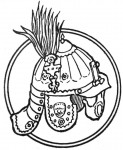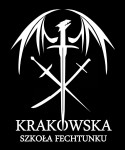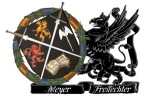Polish sabre fencing: selected issues of sabre fencing system research
April 6, 2019
1. Construction development
The sabre is a weapon used in Europe practically since it was invented. It was already used by the Avars, and sabres dated as early as the 7th century have been found on the continent (Csiky2015). Still, the weapon never became popular on a larger scale, even though it was in constant use in both Poland and the neighbouring countries. This should be treated as particular cases more than a pan-European trend. What is more, it was often abandoned, as among the medieval Hungarians, in favour of the sword, which was more technologically advanced at the time.
The sabre's popularity in Europe was growing gradually, showing in many technological solutions which in the evolution towards the sabre used in the Polish Commonwealth can be treated as intermediary. The first key stage was the Second Crusade. Because of the defeat at Dorylaeum (1147), Western knighthood had to bend before the Seljuk pressure. Subsequently, a new type of weapon was popularized in Europe: the falchion, inspired by the Turkish sabre (Nadolski 1974).
Initially, the falchion appeared in Europe as a cheap equivalent of the sword. It was mainly used by infantry and also appeared in European paintings of the period as the most common depiction of the sabre. [fig 0] Compared to the sword, it had a one-edged blade of much more primitive construction, and a typical sword-like hilt.
 Fig 0. Depiction of Turkish cavalry at Doryleum on an European apinting in 1250, BNF Français 2630 History of Outremer, http://gallica.bnf.fr
Fig 0. Depiction of Turkish cavalry at Doryleum on an European apinting in 1250, BNF Français 2630 History of Outremer, http://gallica.bnf.fr
It is still a common mistake to assume that the sabre quickly became an element of the Arabic armies' equipment during the period of the Crusades. For a long time, the Arabs did not use the sabre,preferring the sword. However, their influence can be observed among their nomadic neighbours: it is visible in the construction and hilt designs of Turkish sabres.
The next stage of the sabre's popularization was the appearance of the langes messer (a longknife). In Polish the term kord poses a number of issues,since it was attached to different types of weapons depending on the period. In this case, it refers to a particular type of battle knife, commonly known as a messer(Ger. “knife”) in the German countries [fig. 1].

Fig. 1. Kriegsmesser, 16th c., National Museum in Krakow
It appeared in a period of a new danger from the East, and first contacts with the Tatars. The messer combined two solutions: thefalchion blade construction and an Eastern-type hilt, riveted orstudded laterally. It was also used mostly for civilian purpose (e.g. self-defence). This development was an important one, sincepreviously knife hilts were set simply by inserting the tang (itcould be pre-heated) into the handle [Fig. 2]. The new constructional solution was used in most knives since the appearance of the messer.

Fig. 2. General constructional differences between sword, falchion, messer and sabre hilts.
 During the next stage, the modern form of the sabre was popularized. The falchion form was developed, along with the popularisation of curved blades. The falchion construction evolved in a very particularway, laying the foundation for the sword-like form of the dussack. [Fig 3.] At the same time, the Eastern sabre gained its final, most recognizable shape, by linking both constructional features. The Polish-Hungarian sabre was the first step towards the
During the next stage, the modern form of the sabre was popularized. The falchion form was developed, along with the popularisation of curved blades. The falchion construction evolved in a very particularway, laying the foundation for the sword-like form of the dussack. [Fig 3.] At the same time, the Eastern sabre gained its final, most recognizable shape, by linking both constructional features. The Polish-Hungarian sabre was the first step towards the
Fig. 3.Gerade versatzung - a defensive position with a dussack. (Meyer 1560)
The subsequent stage was the adaptation of the Polish-Hungarian construction by Saxony, Austria and later by France after the Polish victory at Vienna. Because of wstern developments, the ergonomic form of the hilt was changed, slowly evolving into the army sabre,and the duelling model used until the modern era (Meyer 1934) [Fig.4].

Fig 4.Austrian fencing sabre from the end of 19th century. Pszczyna castle museum. Fot Grzegorz Zygier
2. Sabre fencing in Europe
The history of sabre fencing is interrelated with the development ofcut fencing in Europe. Vegetius (second half of the 4thcentury) already stresses the effectiveness of a thrust against cutwith Celtic or Germanic sword in his manual De rei militari. However, after the fall of the Western Empire in the 5thcentury, the Germanic model of the sword was gaining in popularity,while the short gladius was becoming less popular (Żygulski, 1983). The change is also related to the fighting style, clearly promoting cuts and slices,which was reflected in the weapon constructions. At the same time,the Middle Ages gave rise to a particular type of duels, known asTrial by combat (ordaliain Latin). With their origins in traditional Germanic duels, theywere the basis for specialist fencing.
In that style, point action was once again becoming dominant in the fight (Żabiński 2010). First manuals appeared, and full infrastructure of fencing education was developing. Travelling fencers and teachers contributed to the rising consciousness of the need of fencing training among different social strata. It was then that specialist and common fencingbecamea separated sub-disciplines1.
It is a key division in the history of European fencing, since it created an entirely different model of teaching and tactics. The specialistfencing system wasinitially related concerned with the longsword and the Liechtenauer2school; it is also the basis of the teachings of the German school,and the most characteristic example of medieval specialistfencing, based on the so-called master cuts (Żabiński 2010). At the same time, the Italians, initially basing on the common fencing system in the mid-16thcentury, created their own system, eventually developing it into aspecialist one.Camillo Agrippa (1510-1595), an Italian mathematician and fencer, introduced complicated geometrical operations, creating an entirely new, revolutionary didactic and tactical system. At the end of the16thcentury there was a strong turn towards thrust techniques, forexample in Giacomo di Grassi's book Ragione di adoprarsicuramente l'Arme, si da offesa come da difesa (Bologne,1570). His system quickly became popular all across Europe.
For Northern Europe, the 16thcentury is the era of guild fencing3,where the training system combined the common fencing model with Liechtenauer's style (specialist fencing).The division between cut and thrust fencing was also visible here. Atthe same time, among others, the dussack4appears as the first Western European type of the sabre, as well as aperfect training weapon, a basis for further exercise of one-handed cutting weapons.
In the 17th century, with the onset of the domination of the Italian system, themodel of fencing was also changed. Fencing started to be based mainlyon thrust weapons, while cut fencing was seen rather as a complimentary system. The model of the “art of fencing” was being created, consisting of actions and tactical solutions creating thecore of training and fighting with weapons (Hutton 1901). Still, some forms were not subject to the “art,” with their rules stillrooted in medieval-era common fencing.One of the most important types was the renowned greatsword, the“heir” of the longsword [Fig. 5]. It was called the weapon of masters, and fencing with it was mainly concerned with fighting against groups or its use as a specialized bodyguard weapon (Sarnicki 1580).
Another constructional model is found in the Eastern European sabres. The technique of fighting with such weapons was commonly known as “Polish fencing.” It was practised according to the old model of common fencing,based on simple sequences and sets of moves, instead of one specialized action against a given attack. This model was considered old-fashioned in comparison with the Italian or (later) German and French models.

Fig. 5. Parade greatsword. Parade version of the 16th century geramn greatsword. The Historical Museum of the City of Kraków. fot MHK
In the eyes of the Poles, Eastern fencing was largely differentiated. They distinguished methods particular to the Turks, Russians, Hungarians, and themselves. It can be seen not only in the information mentioned in treatises, but also in the preserved descriptions of methods and different constructional solutions found in the weapons of these nations (Gloger 1896). While the Russians completely subjected their style to Western teachers during the 18th century, it is interesting to see the sources concerning the Hungarians and Turks.
The Turks, who were fiercely hated and greatly respected in Europe at the same time, used a system which was described rather well in a number of Western sources (Paurnfeyndt 1516; MS Germ. Quart 20201510, de Saint Martin 1804, Chatelain 1818). Their fighting technique was developing throughout the 16th and 17th centuries. The evolution of their characteristic moulinet can be observed along with the process. However, the most significant is the distinction between the fighting styles of their infantry and cavalry(Eton 1799). It is related to their preferred types of armaments:cavalry used mostly sabres with characteristic hilts, broadening towards the pommel, while infantry mostly used shorter sabres with broad grips, which were easy to grip. The differences were caused,among others, by the basic type of movement preferred by the Turks: amoulinet performed by wrist action only. According to Guillame Marey's research, a narrow hilt with widening pommel helps inrotation of the sabre, providing support for the little finger; and the broader type of grip provides a good base for the hammer grip,which was favourable for full-arm movement, thus promoting broad cuts. The difference in style came into being because of the factthat Turkish infantry used shields as additional armaments as long as until the end of the 17th century. Unfortunately, by the 18thcentury the fencing skills of the Turkish infantry had already fallen considerably, which is frequently mentioned in literature. The cavalry's skills, on the other hand, were widely renowned even in the 19th century (Eton 1799, Chatelain 1818).

Fig. 6 Polish Hungarian sabre from 17th century. National Museum, Kraków. Fot MNK.
At least two Turkish techniques can be found in German fencing books from the 15th and 16thcenturies, both for infantry and cavalry (MS Germ Quart 202; Paurnfeindt 1516, and others). The Turkish slice and Turkish cut are a very interesting instances, which can be observed across a few centuries. We read about it even in the context of the 18th or 19th centuries. On the other hand, 18th-century sources inform about the upward cut, preferred by the Turks. What is more, in Poland the Turkish cut is done upwards, from the right; it is also known as the nyżek, and in Austria, Saxony, and later in Prussia as the Hellish Polish Quart (Ger. höllische polnische Quarte; Starzewski 1840). The Polish quart, being a very recognizable and characteristic technique, shows how this Turkish cut was perceived in Europe through the lens of the Poles' abilities. What is more, many Polish-type sabres hilted in Austria display primarily the characteristics of a Turkish sabre. This underlines how the Polish technique was perceived in Vienna.
 The Hungarians preferred a different style, known in Poland as the Hungarian swing (Gloger 1896). This characteristically Hungarian action can be found both in 18th- and 19th-century sources (e.g. Valville 1817; Bartelli 1800; de Saint Martin 1804).The hussars' technique became popular in Europe at the time. It is a particular position of a swing from the left shoulder, which is the basis for strong and unusually effective sabre action. Descriptions can be found in a number of fencing manuals, related to the use of the Hungarian sabre type [Fig. 7].
The Hungarians preferred a different style, known in Poland as the Hungarian swing (Gloger 1896). This characteristically Hungarian action can be found both in 18th- and 19th-century sources (e.g. Valville 1817; Bartelli 1800; de Saint Martin 1804).The hussars' technique became popular in Europe at the time. It is a particular position of a swing from the left shoulder, which is the basis for strong and unusually effective sabre action. Descriptions can be found in a number of fencing manuals, related to the use of the Hungarian sabre type [Fig. 7].
Fig. 7. Hungarian swing. Bartelli 1800
The characteristic element is the use of a broad swing, complemented with a moulinet (Valville 1817).
The final form of the Hungarian sabre construction, which was copiedby many Western European armies, took its shape during the 18thcentury. It was characterised by a broad, slanted handle, narrowing towards the pommel [Fig. 8]. Broad spear point blades were used; theygreatly helped the cut with their inertia.
Fig . 8.Hungarian hussars sabre. Jagiellonian University Museum. fot Grzegorz Zygier.
The use of the Hungarian swing in Poland can be attested not only by the construction of Polish sabres, which is related to that of Hungarian ones, but also by the clearly visible influence of late Hungarian constructions on the already formed shape of the hussar sabre hilt [Fig. 10]. The Hungarian model and mechanics are also seen in many Western European sources (de Saint Martin 1804; Perinat 1758; and others), for example in the Espadon style, that is, French cut fencing. A number of fencing manuals describe work with the swing of the whole arm, as well as a characteristic drawing movement, which is described in several books, for example by Alexandre Valville's (18th-19th c.) Traité sur la Contre-Pointe (St. Petersburg1817).
 Fig. 9 Nnicola Zrinski (1620 -1664) , anonymous, source: Wikipedia
Fig. 9 Nnicola Zrinski (1620 -1664) , anonymous, source: Wikipedia
It is worth mentioning that the position is frequently used in iconographic depictions of Hungarian heroes of the 17th and 18th centuries (Fig. 9). Tracing the history of this movement pattern is important for the research of the style, since such movement can be found as early as in the medieval period. The Rossfechten, that is the German method of mounted fencing, is a very developed type of fencing. Unfortunately, it was sparsely described in the subsequent centuries;it is only the 18th- and 19th-century military manuals the method is mentioned again, however in a simplified form.It may also be linked with such countries as Poland and Hungary,where the tradition of fighting on horseback was very well rooted and widely practised. One of the most important actions used against the lance and spear was the cut and thrust, done by a swing from the left shoulder (Liberi 1400).
The last of the interesting traces is the Contre-Pointe,the final form of French cut fencing. It is a combination of the Hungarian cut and the French thrust. It is also a heritage of Hungarian style. It dominated most European cut fencing styles at the end of the 19th century (Grisier 1847).
3. Sabre fencing in Poland
Polish fencing used both Eastern and Western patterns. Currently no information can be found about any historical treatises, which would allow for its full description. Nonetheless, there are several indirect sources, which allow for its characterization. The actions found in Polish fencing include cross-cuts, the Hungarian swing, the Turkish cut (so-called Polish quart), and several types of the moulinet. Their combination created a very dynamic and effective fighting technique.
 Fig. 9 Polish Hussar sabre, late 17th century. Czartoryski Collection Museum. Fot MNK
Fig. 9 Polish Hussar sabre, late 17th century. Czartoryski Collection Museum. Fot MNK
Polish cross-cut fencing is difficult to trace as a term, even though its evolution can be described easily. The earliest Polish-language mentions of the system come from the 16th century. Stanisław Sarnicki (1532-1597) describes the basic actions of cross-cut fencing in his Księgi hetmańskie (1580).However, these actions are ascribed to the German greatsword. As it was mentioned before, greatsword fencing is a part of the medieval heritage of common fencing.Already in the 17th century, the name of cross-cut fencing was attributed to Polish cut fencing, e.g. by Erhardus Henning (active in the 17th century). The key issue is the way such cuts were performed. In the 18th century, some French and German manuals, especially ones describing mounted fencing, already describe the cross-cutting action as a finishing of the attack sequence during an exchange of sabre blows.It is done by a moulinet where only the wrist is used. The technique's relation to the Polish one is of secondary importance,what is most important here, is to stress the appearance of cross-cuts in many forms of cut fencing. The existence of such forms in a sequence, where a series of actions is finished with several cuts making a cross, can already be observed in the 16th century. The last author of the period to use this action in infantry fencing was Joachim Meyer (Meyer 1570).
The moulinet was a very interesting, and substantial aspect of movement related to Polish arms. It can be seen in the construction of the Polish sabres,combining Hungarian and Turkish elements. The broad handle enables a strong grip, while on the other hand the characteristically broadened pommel ending with a cap is very favourable for the use of the Turkish moulinet. The combination of these two worlds can be clearly seen as a successor methods. Austrian fencing, basing on the moulinet and exclusive rotation of the wrist, has been shaped during the 18th century and evolved until the end of the 19th.It had substantial influence on such systems as the English, e.g.Rules and Regulations... (1796) by Gaspard le Marchant (1766-1813), or Prussian fencing, exemplified by the sabre fighting technique popularized by Gerhard von Blücher(1742-1819).
These facts are stressed in Polish 19th -century manuals, which largely base on this method, particularly in Ivanowski's book (Nouveau système d'escrime pour la cavalerie, Paris 1834). Even though the system was seemingly similar to the English one, it was different in many aspects, which was underlined both by its critics and supporters, for example in Le Spectateur militaire(1834). Ivanowski very clearly described the method of using the hand as the primary source of movement, recalling the Polish origins of the technique (Ivanowski 1834).
Three main movement patterns dominated in Polish cut fencing of the 17th and 18th centuries. All of those are based on the medieval tactical model of common fencing, which was known in Poland in the form of so-called cross-cut fencing. The pattern became an integral part of the Polish system to such a degree that, since the 17th century, German sources identify it with Poland. Another type was the cut with the whole arm, strongly related to the Hungarian construction of the sabre and rooted in the cavalry systems of the Middle Ages; the third, Turkish type, was based on the moulinet where the upward cut dominated, becoming legendary in Saxon fencing as the Hellish Polish Quart. All those patterns can be seen in the construction of weapons used in the Polish Commonwealth. The hussar sabre and karabela are both great examples. These two most characteristic sabres of the era were mainly used in Commonwealth territories. The hussar sabre has a Hungarian-type handle complemented by a broadened pommel; it expands the older model with a broadened handle giving a base for the whole hand during the moulinet, enhancing the possibilities of cutting with the whole arm.These are signs of a developed form of fencing with deep roots laying in the medieval systems.
Footnotes:
1. Specialist and common fencing are two different forms of tactical and didactic understanding of the fight.
Specialist fencing: actions are countered with specialized actions.
Common fencing: sequences of the most simple actions are used to create an opening and use it to reach the opponent.
2. Johannes Liechtenauer, known as the Grand Master of the German school, created a very well-developed training system, which became the basis for all subsequent fencing schools.
3. Fencing guilds were created in the 15th and 16th centuries. The Brotherhood of Saint Mark was the first fully legalized organization, entitled to train fencers in the German countries.
4. “Dussack” is a term with two meanings: first is a wooden weapon used to train cut fencing, and the second, a sabre with a falchion-type hilt, frequently with complex hand protection.












